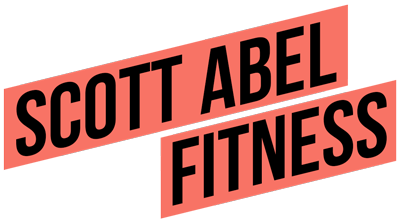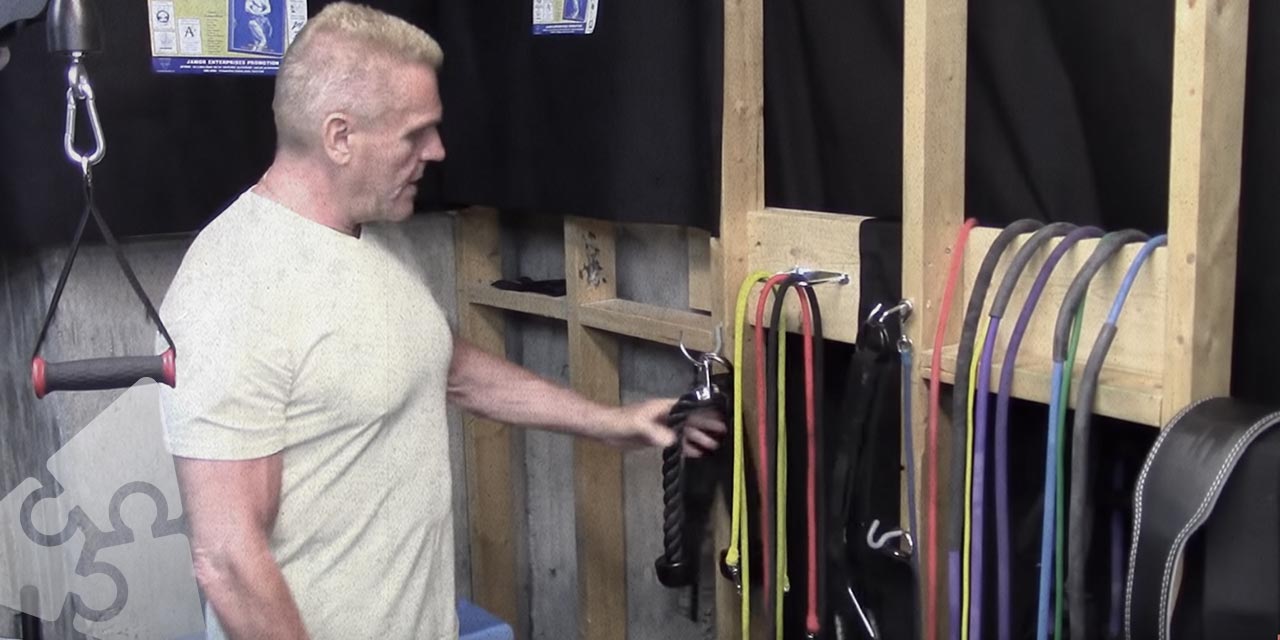I recently posted a walk-through video of my home gym.
After I did so, I got a number of emails and comments from people about “where to start” for their own home gym. There are good reasons to train or workout at home:
- You can save money on membership fees.
- You can save money on being charged for gym services you may not use (the pool, classes, etc.)
- Some gyms have inconvenient opening and closing hours, especially on weekends or holidays
- At commercial gyms you might have to wait for equipment.
- At commercial gyms some people just plain don’t have very good gym etiquette.
- You feel self-conscious about exercising in a public setting
So, in this article I’ll outline which items I recommend you purchase for your home gym, in order of importance.
A lot of advice online says to start with a cheap squat cage and a barbell. I disagree. I think those should be one of the last things you buy! If you’ve read my work (e.g., The Abel Approach) you know that there’s more to sculpting a physique than squats, bench and deadlifts. You need to stimulate your muscles from variety of ranges and planes of motion and things like that. As you’ll see, this is why I recommend adjustable dumbbells as your first purchase.
Before we get to that, though, I do want to note that not all environments are conducive to producing actual results. There is a reason many people get better results at gyms then they do on their own trying to exercise at home. Just because you want to get results by using a single pair of 10-lb dumbbells and a corner of your laundry room doesn’t mean you will.
Do you have enough space for a home gym?
Having “a” space doesn’t mean you have enough space. I am continually amazed by the number of people who write me who want to workout at home and they think having one kettlebell and/or one medicine ball and a mat beside their washer and dryer. I’m sorry, but that’s not a good enough space for an effective workout.
Similarly people write me who want to use their living rooms for working out and they have no equipment and one yoga mat.
These situations are not conducive to achieving real results. They’re just not.
Yes, with a little know-how a lot can be accomplished with limitations. Heck, in my late teens I did push ups in my bedroom and I got to being able to do 1,000 push ups in less than 45 minutes—and my physique actually did change from this. But it didn’t change all that much, and frankly, I was also in my hormonal prime—any kind of muscle stimulation would have had some kind of cosmetic result, but I suspect that most people reading this aren’t 15 years old any more.
Similarly, I advise clients all the time on hotel room bodyweight circuits of push ups, sit ups, squats, leg raises, alternating lunges, then repeat. These are great as “fill-ins” for a larger program when you’re traveling and have to make do. However, by themselves, they won’t suffice as a permanent solution.
Another factor here is that, generally, people who want to exercise at home with limited space tend to be the kind of people who don’t have the expertise to devise a program to make do. This is true in terms of program design, but also in terms of things like intensity. Many people would benefit from going to a good gym just to get a sense of what a solid workout actually looks like.
Creating a good home training environment
So, with that out of the way, let’s get real.
Ideally, your workout space should be separate from your regular living space in some way. In my own home gym, I made the room separate from the rest of my basement. Although I don’t have drywall up for one side, I have black curtains so that I don’t have to see or look at my furnace room. Likewise, I know people who have done amazing jobs converting their garages or outdoor sheds into viable workout spaces.
The key here is that the environment is conduce to solid training. You won’t be distracted by the dog or your kids. If possible, your workout room should even include motivating and inspiring stimuli. Put up some posters of people who motivate and inspire you.
You don’t need to have every single piece of equipment from the get go and you don’t need to buy the best of the best of equipment you don’t even know how to use yet. Start with the basics and build from there.
The Must Haves
An adjustable bench and a pair of selectorized dumbbells is my “bare minimum” for a home gym. (It's also what the Busy Woman's program is designed around.)
An adjustable bench.
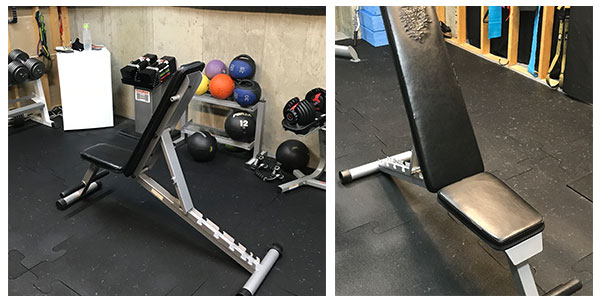
An adjustable workout bench offers seated and lying variations and gradations which themselves offer a variety of planes and ranges of motion for exercise choices.
Adjustable dumbbells (preferably selectorized) up to 50 lbs at minimum.
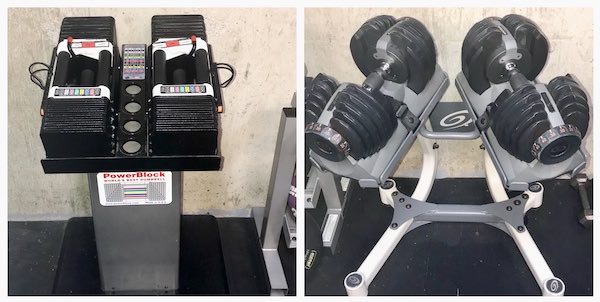
Powerblocks and Bowflex selectorized dumbbells are excellent. Selectorized dumbbells take up less space and they allow you to vary the weight almost instantly, which is very important. Gone are the days of changing weights between sets on dumbbells by having to unclamp them then clamp them back up again.
You need enough variety in the dumbbells to give you progressive overload.
Sometimes people will write me and say, “I have 10 lbs dumbbells; is that good enough?” The answer, unfortunately, is no. That won’t have enough for most exercises. Likewise, even if you only have a pair of 35-lb dumbbells, that might give you enough resistance for a few exercises, but it’ll be too much or too little for others.
The Very Good to Haves
A dumbbell rack.
When first setting up your home gym, I strongly encourage you to buy your selectorized dumbbells with whatever rack stations they come with. The racks are usually sold separately, but they make your training safer, cleaner, and more convenient to switch weights.
Good flooring
Good flooring helps more than you might think. If you can’t afford to install rubber flooring then at least have rubber mats you can use. If you’re worried about damaging your floor, you can’t really have an effective workout. You can use carpets or other workarounds, depending on your situation, but it’s not ideal.
If you are on carpeted floors, then your exercise shoes are going to have to be well thought out as well with great lateral support and rubber grip.
Resistance Bands
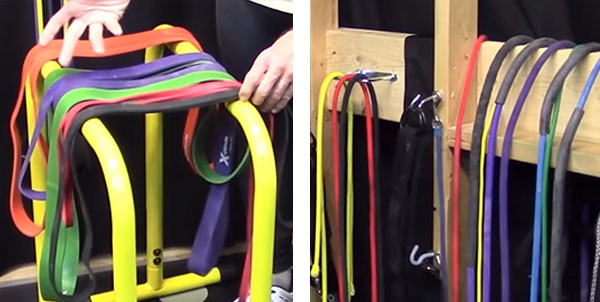
For very minimal cost, you can add a complete set of both round and flat resistance bands, with and without handles. You would be amazed how many exercises you do with resistance bands and how good those exercises feel.
Resistance bands give you a whole new level of exercise options, and they have a different feel on the muscles than dumbbells and free weights. They are a fun added tool in the tool box to have.
But again, you want to invest in various resistance levels, just as I mentioned to do with dumbbells. Most of these now come in a “set” so it’s not much of an issue.
Pillars and solid mounts for the resistance bands.
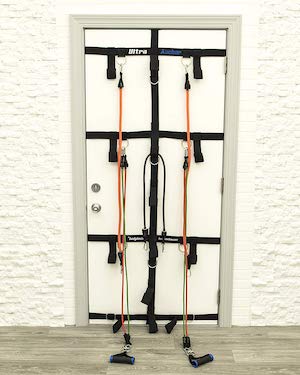
A door mount system from Bodylastics.
If you have a structure where you can attach hooks or mounts at low, medium and high positions it’s easier to use your resistance bands from a variaty of different angles that nicely mimic cable work you’d do in a commercial gym.
Door mounts are the most the common but you have to make sure your door closes the right way so that there is no chance of it swinging open (or even breaking) from your pushing and pulling on it.
The Nice to Haves
If you have the above, you have everything you need, but it’s still possible to add some equipment that’ll improve your setup.
Dual-axis cable machine.

A “dual” axis cable machine lets you adjust the cable across two axes: upidown and side-to-side. If you have the space and the money, a dual axis cable machine where both arms of the machine move vertically and horizontally will also allow you to mimic dozens of commercial machines at a gym as well as create exercises that you can’t do in a standard set machine that has one single function only.
An olympic barbell and a squat rack.
Last, although I am much more partial to dumbbells and an adjustable bench, having an Olympic barbell and a safety squat rack can be useful for things like squats, deadlifts, barbell rows, or even barbell bench press with the rack's safeties. But again: if your goals are cosmetic enhancement (i.e. you want to look good), the other stuff really is more of a priority!
Build Your Gym from These Basics!
Trust me once you have just a few of these basics and you have a solid program to follow, training at home will become something you look forward to. This will motivate you to keep adding to your equipment base, and build from there.
